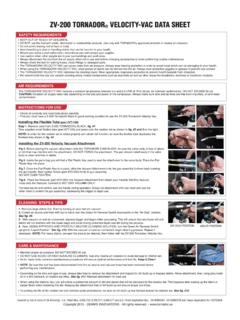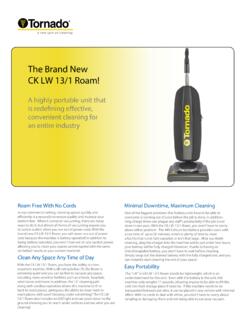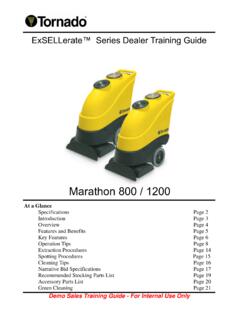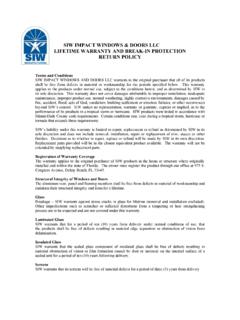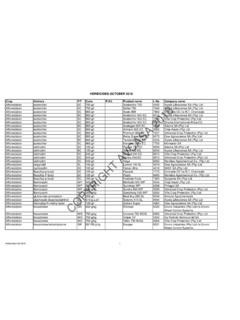Transcription of Storm Shelters: Selecting Design Criteria
1 Page of 5 Storm shelters : Selecting Design Criteria HSFEHQ-07-J-0020 / August 2007 Purpose and Intended AudienceThe intended audience for this Tornado Recovery Advisory (RA) is anyone involved in the planning, policy-making, Design , construction, or approval of tornado shelters , including designers, emergency managers, public officials, policy or decision makers, building code officials, and home or building owners. Homeowners and renters should also refer to the Tornado RA titled Residential Sheltering: In-Residence and Stand-Alone shelters . The purpose of this advisory is to present information on different types of shelter Design guidelines, code requirements, and other Criteria that pertain to the Design and construction of tornado shelters . There are various Storm shelter Criteria , each of which offers different levels of protection to its shelter Recovery Advisory Addresses:How shelter construction is different from typical building construction:Structural systemsWindborne debris resistanceDesign Criteria for different types of sheltersUseful links and shelter resourcesHow Shelter Construction is Different from Typical Building ConstructionA tornado shelter is typically an interior room, space within a building, or an entirely separate building, designed and constructed to protect its occupants from tornado wind forces and windborne debris.
2 The level of occupant protection provided by a space specifically designed as a shelter is intended to be much greater than the protection provided by buildings that comply with the minimum requirements of building codes. The model building codes do not provide Design and construction Criteria for life safety for sheltering, nor do they provide Design Criteria for withstanding the forces of typically fall into two categories: residential shelters and community (non-residential) tornado shelters are constructed as in-residence or easily accessible external shelters . An in-residence shelter, also called a safe room, is a small, specially designed ( hardened ) room, such as a bathroom or closet that is intended to provide a place of refuge for the people who live in the house. An external residential shelter is similar in function and Design , but it is a separate structure installed outside of the house, either above or below ground.
3 Refer also to the Tornado RA titled Residential Sheltering: In-Residence and Stand-Alone community shelter is intended to protect a large number of people, anywhere from 12 to as many as several hundred individuals. These shelters include not only public shelters , but also private shelters for businesses and other organizations. See these 2007 Tornado Recovery Advisories for information about sheltering from tornadoes:Tornado Risks and Hazards in the Midwest United States (Tornado RA1)Residential Sheltering: In-Residence and Stand-Alone shelters (Tornado RA 3) Storm shelters : Selecting Design CriteriaThe term hardened refers to specialized Design and construction applied to a room or building to allow it to resist wind pressures and windborne debris impacts during a high-wind event and serve as a 2007 TORNADO RECOVERY ADVISORY FEMA DR-1699-RA2 Storm shelters : Selecting Design Criteria HSFEHQ-07-J-0020 / August 2007 Page 2 of 5 Structural SystemsThe primary difference in a building s structural system when designed for use as a shelter, versus conventional use, is the magnitude of the wind forces it is designed to are designed to withstand a certain wind speed (termed Design [basic] wind speed ) based on historic wind speeds documented for different areas of the country.
4 The Design wind speed used in conventional construction in the Midwest is a 90 mph, 3-second gust. By contrast, the Design wind speed recommended by FEMA1 for shelters in this same area is a 250 mph, 3-second gust to provide near-absolute protection. 2 Wind pressures are calculated as a function of the square of the Design wind speed. As a result, the structural systems of a shelter are designed for forces several times higher than those used for typical building construction. Consequently, the structural systems used in shelters (and the connections between them) are very Debris Resistance Windborne debris, commonly referred to as missiles, causes many of the injuries and much of the damage from tornadoes. Windows and the glazing in exterior doors of conventional buildings are not required to resist windborne debris, except for those in windborne debris regions (which are limited to hurricane-prone regions).3 Debris protection includes impact-resistant glazing, which can either be laminated glass or polycarbonate, and coverings such as shutters.
5 The ASCE 7 missile Criteria were developed to minimize property damage and improve building performance; they were not developed to protect occupants. To provide occupant protection, the Criteria used in designing shelters include substantially greater windborne debris roof deck, walls, and doors of conventional construction are also not required by the building code to resist windborne debris. However, the roof deck and walls around a shelter space, and the doors leading into it, must resist windborne debris. Additional information regarding the different levels of windborne debris loads is provided below. Design Criteria for Different Types of shelters shelters provide different levels of protection depending on the Design Criteria used. The level of protection provided by a shelter is a function of the Design wind speed (and resulting wind pressure) used in designing the shelter, and of the windborne debris load wind speed and wind pressure Criteria : The required Design strength of the shelter is dictated by wind pressure Criteria given by different guides, codes, and standards.
6 The Design wind pressure is a function of the Design wind speed. In FEMA s shelter publications (see Useful Links on page 3), recommended Design wind speeds range from 160 to 250 mph. However, the 2006 International Residential Code and the 2006 International Building Code, which establish the minimum requirements for residential and other building construction, include a Design wind speed of 90 mph in the Midwest. The table on page 4 compares shelter Design Criteria options. The table on page 5 presents comparative data for two locations using the Design Criteria presented on page FEMA 361, Design and Construction Guidance for Community shelters (July 2000), available online at Near-absolute protection means that, based on our knowledge of tornadoes and hurricanes, a shelter built according to this guidance will protect its occupants from injury or death. FEMA 361, page 1-2, Design and Construction Guidance for Community shelters (2000).
7 3. ASCE 7, American Society of Civil Engineers Standard 7, Minimum Design Loads for Buildings and Other Structures (2005).If glazing is present in a tornado shelter, it should be protected by an interior-mounted shutter that can be rapidly deployed by the shelter Storm shelter being constructed to FEMA 361 Criteria in Wichita, of 5 Storm shelters : Selecting Design Criteria HSFEHQ-07-J-0020 / August 2007 Windborne debris load Criteria : The table below presents windborne debris Criteria given in current FEMA guidance and a proposed International Code Council standard. The table shows different test missiles and their corresponding momentum. The first entry in this table is the FEMA missile guidance for residential and community shelters . These parameters provide near-absolute and Hurricane Windborne Debris Criteria Guidance, Code, or StandardCriteria for the Design MissileDebris Test Speed (mph)Large Missile SpecimenMomentum at Impact (lbf-s)Tornado Missile Testing RequirementsFEMA 320 / FEMA 36110015# 2x468 International Code Council (ICC) Proposed Shelter Standard100 (maximum)80 (minimum)15# 2x415# 2x46855 NOTES:lbf-s Pounds (force) secondsUseful Links and Shelter Resources:Taking Shelter From the Storm : Building a Safe Room Inside Your House (FEMA 320), FEMA, Washington, DC, Second Edition, March and Construction Guidance for Community shelters (FEMA 361), FEMA, Washington, DC, July Protection.
8 Selecting Refuge Areas in Buildings (FEMA 431), FEMA, Washington, DC, November on the Design and Construction of Storm shelters , International Code Council and the National Storm Shelter Association (ICC-500), (Anticipated Release) Early Mitigation Manual for Light Frame Construction by David Wickersheimer, State Farm Fire and Casualty Company, FEMA Region V, 320 FEMA 361 FEMA 431 Storm shelters : Selecting Design Criteria HSFEHQ-07-J-0020 / August 2007 Page of 5 Wind Shelter Design and Construction Codes, Standards, Guidance Comparison Table Title or Name of DocumentCode, Reg, Standard, or Statute?Wind HazardWind Map2 Wind Design Coefficient Considerations , Debris Impact Criteria5 RemarksFEMA Shelter Publications:FEMA 20 Taking Shelter From the Storm : Building a Safe Room Inside Your House (2004)FEMA 6 Design and Construction Guidance for Community SheltersFEMA guidance document, not a code or standard. Best Practice for high-wind sheltersTornado and HurricaneFEMA 20: Hazard map, but wind speeds not used for designFEMA 6 : Map with four wind speed zones for Design (wind mri is 10,000 100,000 years).
9 This map is often referred to as the FEMA 361 map. FEMA 20: N/A prescriptive Design guidance for maximum hazardFEMA 6 : Use FEMA 361 wind speed map with four zones. Calculate pressures using ASCE 7 methods and use I= , Kd= , Exposure C, no topographic effects, GCpi=+ (this will account for atmospheric pressure change [APC])Test all shelters with the representative missile: a 15-lb 2x4 at 100 mph (horizontal) and 67 mph (vertical)FEMA 20: Intent is to provide near-absolute protection. No certification is 6 : Intent is to provide near-absolute protection. Shelter operations guidance is provided. Occupancy issues addressed. Wall section details provided. No certification is Code Council/National Storm Shelter Association (ICC/NSSA) High Wind Shelter Standard (ICC-500) currently in development, tentatively available for adoption in January standard for shelter Design and construction, available for adoption in January 2008.
10 To be incorporated by reference into the 2009 IBC and and HurricaneTornado: Uses FEMA 361 : Use FEMA 361 wind speed map. Calculate pressures using ASCE 7 methods and use I= , Kd= , Exposure as appropriate, no topographic effects, GCpi=+ or + +APCTest shelters with representative missile (missile speed dependent on site Design wind speed): Tornado: 15-lb 2x4 at 85 100 mph (horizontal) and 2/3 of this speed (vertical).Intent is to provide a standard for the Design and construction of high-wind shelters . Will not use term near-absolute protection. Occupancy, ventilation, and use issues are also addressed. Shelter operations guidance is provided in the commentary only (commentary is a separate document not a consensus document). International Building Code (IBC)/International Residential Code (IRC) 2000 and later/ASCE 7-98 and code and Design standards for regular (non-shelter) buildings. Some additional guidance is provided in but tornadoASCE has its own wind speed map based on historical and probabilistic data; mri is 50 years in non-hurricane-prone is basis of most wind pressure calculation methods.
